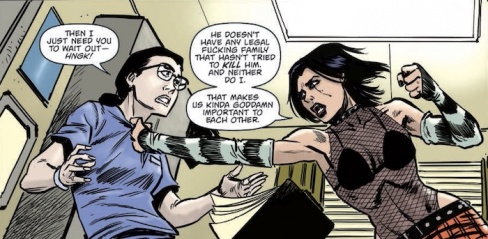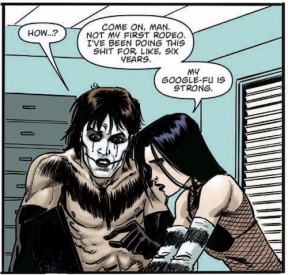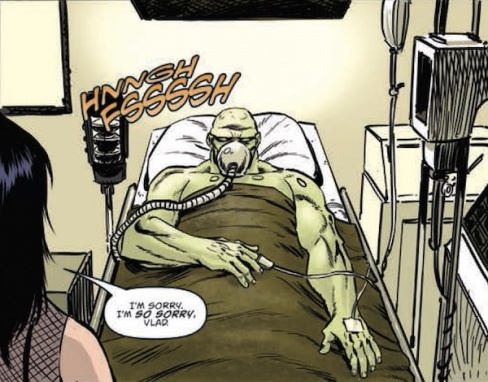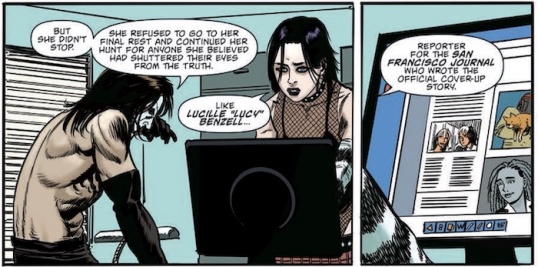Welcome to Butcher’s Block, our “Hack/Slash” annotation. Today we’ll be going over the second installment of “The Crow: Hack/Slash.”
As a note: unlike some other analyses, this one will not skimp on spoilers, though it will still attempt to be new reader friendly by way of bringing up past information.
Furthermore, for sake of clarity: “Hack/Slash” is a mature comic book series. As such, many images may not be suitable for younger audiences, and quotations and/or panels may include liberal curses and mature content such as profanity, violence, or sexual imagery.
New Concepts
Family

Technically speaking, Cassandra “Cassie” Hack isn’t exactly accurate in her assessment of the trust she and Vlad have in their biological family members, at least in her own case. Her father, Doctor Jack Hack, and her maternal ancestor, Caraway Cordero, each did not try to kill her, with the former’s main crime being that he was not there for her, and the latter even helping her out in her vampire troubles around Haverhill. That said, Cassie Hack isn’t exactly known for the best of judgment or accurate assessment of situations when under stress.
That said, she does have a point, for the most part. Barring Dr. Hack (who is dead) and Ms. Cordero (who is definitely not a people person or likely willing to go out of her way to help beyond her territory), both she and Vlad have extremely bad relations with their biological families.
In terms of Cassie, her relationship with her family is mostly colored by her antagonism toward her mother, Delilah “Lunch Lady” Hack. Forced to face her no less than four times at this point (twice alive, once as an undead slasher, and once as a ghost inhabiting a valkyrie), the sheer terror involved in their interactions, coupled with hate and, in spite of herself, at times a slight daughterly affection, it’s no wonder that Ms. Hack sees her family as nothing to rely on and essentially considers herself the only remaining member of it. The fact that her last two times with her mother involved being directly attacked or her attacking Vlad (in that order) does not help things in the slightest. In fact, in “Hack/Slash Resurrection,” she seems to see Caraway Cordero as more the relative of Delilah than of herself, though that may just be a change of wording on her part on account of Caraway’s surname being still the same as Delilah’s maiden name.
For Vlad’s part, his biological family on his mother’s side draws direct lineage to the infamous (and possibly fictitious or exaggerated in real life) cannibal Alexander “Sawney” Beane and his 48-member clan in sixteenth century Scotland, with the addition of a “boon” of supernatural strength and durability (on top of his unusual appearance) from Beane’s one-night stand with a demoness in his relative youth. The surviving members seen are, by and large, rather homicidal, running a Scottish crime family in Chicago, Illinois, from which Vlad’s mother Kaelyn ran shortly before her death. However, as Vlad noted at the grave of the butcher who raised him after his as-of-yet last encounter with the family in “Hack/Slash” #17, “It is good to know where you come from. But more important, I think, to know who you are. I am not a Beane. I am not a monster. They are where I come from. But this man, my mother, Butcher. They are who I am.”
The few times that Vlad encountered the clan, they tried to integrate him into their family in spite of him being “impure” (that is, not the result of their standard inbreeding practices), attempting to force him to eat human flesh and even forcing him into gladiatorial battle against his much stronger… male relative (some combination of uncle and cousin) when he refused. On top of all of that, they also tried to feed him his friends’ body parts, including some of Cassie herself (though she escaped before she could lose anything). Due to the death of all of the known members, on top of the fact that any survivors wouldn’t exactly hold him in high regard considering his part in the fall of their family from power, it’s probably safe to say that Vlad isn’t exactly going to be sent holiday cards any time soon.
Continued belowThe closest thing to family that Cassie and Vlad have, beyond their pseudo sibling relationship, is the variable Hack/Slash, Inc. team, with emphasis on certain members more than others. Treated like an extended family in and of itself, they tend to call on each other for aid when necessary and even hang out with one another on their better days. However, the latter seems to have mostly fallen by the wayside since the events of ‘Final,’ with only the calls for aid really being the focus anymore. Still, that connection remains the closest to family they have.
Notoriety

Over the years, Cassie has had varying degrees of notoriety, both fame and infamy. Her exploits are practically an urban legend in their own right, not unlike the killers, to the point of being mentioned on a late night supernatural occurrence talk show known as “Late Knight AM” starring retired superhero Alan Knight (long story). While this kind of attention isn’t seen as a bad thing, and she even seems to be a fan of the program to the point of being shocked and embarrassed when called up by the host for a job, it remains a source of random people’s knowledge of the “S.K.K.,” as she is known.
On the fame side, she is well known enough that various people were able to call in to get her to help with their supernatural killers, mostly in the form of slashers, and at their height as calls during the lifetime of Hack/Slash, Inc. On occasion, she has even been attempted to be effectively conscripted into capturing or otherwise helping to research slashers for others such as the unnamed conspiracy tied to Ceutotech, Inc., but to no real effect in their favor. Of course, this also led to or involved some tricks or traps, but the point stands that her cross-country adventures did bring about quite a lot of knowledge from people beyond her own targets.
For infamy, her self-given crusade led her to be known by some assailants even before she personally met them. While some, like Liberty “Libby” Lochs, only really came across her because of her direct actions impacting her family, others, like Charles Lee “Chucky” Ray of the Child’s Play franchise, know of her from sheer scope of her actions. To quote the aforementioned Lakeshore Strangler himself, “Yeah, and you’re Cassie Hack, the Slayer of Killers. You took out some good psychos. Guys after my own heart.”
The fact that her travels involved quite a lot of crimes, including (but by no means limited to) breaking and entering, assault, battery, and arson, among many others, does not help, as keeping off of police watch lists can be difficult (though further discussion of her criminal record can be saved for another time, if we get more police interaction). Even with her rap sheet wiped clean by the police on at least one occasion, the rampant criminal behaviors drive her further toward infamy in the eye of the authorities, even if she is seen as more of a heroic figure to those she saves for the most part.
Research

Cassie’s habit of researching her targets over her eight or more years hunting (despite her comment of six, but that’s mostly irrelevant semantics after some retirement and time travel) proves to be the most common method in regards to finding out their identities and origins. Of course, any hunter would want to know more about their prey, and as she hunts the most dangerous game of all, she has to keep herself up to date on new weak points, be they psychological or physical. A recurring trend is the return of a previous scene with added context through the research as a voiceover, before going on to further attacks to expand on said context, as shown with Angeles Cero in “The Crow: Hack/Slash” #2 with the help of Marcus Grieves’s explanations.
The research itself tends to proceed in two stages. The first stage involves conversations coupled with possible momentary conflict with the killer (or killers) of the hunt. The second involves more in the way of looking over records by using information gleaned from the first stage.
Continued belowThe practice of talking with others to gain information began after her first intentional hunt against Matthew “Grinface” Ravenswood in Buffalo Center, Iowa. Due to her lack of enough information, she misidentified the killer as a farmer due to local legends. (Though Tim Seeley originally did have Farmer Fig as the killer, that’s less relevant from a narrative perspective at this point.) The hunt did go well (by her standards, in any case), but the experience drove her to concentrate harder on parsing out what people are saying in order to supplement her work on her own, as finding out how a killer works in truth primarily through directly fighting him or her is not exactly the most reliable, nor the safest, method of research. From Bobby Brunswick (in ‘Euthanized,’ the first published story) onward, Cassie makes sure to use conversations, from those directly with potential victims or other hunters to ones she eavesdrops upon from the killers themselves, to figure out enough information to go on for her own second stage of intelligence gathering.
The second, more notable stage of the research into killers comes from assessing information in various records, be they public or private. After finding out a killer’s name, alias, and/or modus operandi, she has enough to look through journals, news articles, library records, Internet hearsay, or even morgue documentation and more to find out how the killer died, what they did in life, who they may be targeting, and why they came back from the dead (if the latter is applicable). Despite being the second part of the research process, this one began shortly after killing the Lunch Lady a second time, with her looking into legends of undead killers (including some famous horror franchises that are apparently real in her world). Sometimes, rather than do the research herself, she has a support team, Hack/Slash, Inc. (the aforementioned surrogate family) to help her out, but with their dissolution following the events of ‘Final,’ she and Vlad primarily rely on looking through things on their own.
Of course, the process of research is by no means perfect. Aside from the issues in Iowa, she also attacked Vlad in Chicago under the mistaken belief that he was a serial killer through more of her typical processes (both through records and presumably through conversations with Chicagoans), but at least it’s something.
Pragmatism

The sheer level of pragmatism in her methods is a large part of Cassie’s overall style, mostly in terms of combat. If it can be a weapon, she will turn it into one or attempt to turn it to her advantage, from actual weapons she brought with her, to ones dropped by her assailants, to random items lying around, all to gruesome effect. Though firearms and her knife and baseball bat are her general go-to options, the fact is that in order to trap a killer, there are few lows too far for the Serial Killer Killer. When it comes to allies in particular, it’s almost expected for them to be a meat shield or bait for a trap at some point or another, though she will try to avoid any permanent damage. As such, the meat shield tactic she used off the cuff when trying to escape from the police (not for the first time in her life, either) is hardly the worst thing she could have done, though unusually for her, she actually apologized for it afterwards.
Continued belowNew Issues
The Crow: Hack/Slash #2

Vlad’s hospitalization has had a serious effect on Cassie Hack. Her best friend being injured tends to worry Cassie quite a lot, leading to snapping at others rather frequently if not blaming herself (or, as the case may be this time, both). Some of the times he has been injured or otherwise sick, she has blamed it entirely on herself, and not without reason. From spending too much time on her phone talking with Margaret Crump leading to his going for a walk alone outside and being smashed in the head with a stone bird bath, to her self-loathing about his death at the end of ‘Final,’ and more, Hack internalizes much of the blame in general. It may not be entirely healthy, but there aren’t many people she will listen to in that regard, and even fewer who are alive and willing to pull her out of her despair. Rather than deal with it directly, she opts to bury herself in her next mission of revenge, as per usual.

As shown through the examination of her villainous origin story, Angeles Cero’s motivations have moved away from her original vengeance, as implied in “The Crow: Hack/Slash” #1. She has gone from hunting after those who killed her and her sister and the people who helped cover it up to anyone and everyone who played “mute witness” to the crime, from the reporter who wrote the official cover up story (Lucy from the previous issue) to targeting the mayor and police chief by the end of the issue for the fact that, allegedly, “Nothing happens in this town without you knowing about it.”
The idea of motivational decay is not uncommon in fiction, let alone real life. Some people find such fulfillment in their own actions, or are otherwise addicted to them, that even when there is no logical reason why they should continue, they will make up new justifications in order to keep moving forward. Decaying motives allow for villains and heroes both to evolve, or in some cases devolve, becoming very different people that they can scarcely recognize if they look at themselves later.
Such a change is so common in both reality and fiction that it can be nearly a waste to even bring up examples, but the devolution is seen in certain slashers. Bobby Brunswick turned from a well-meaning but upset man who would never hurt Lisa Elsten himself to someone who directly sought her out. Angela Cicero, the Acid Angel, turned from someone who “[doesn’t] usually kill women anyway” to a killer of both men and their girlfriends in horrific acid-based deaths. Both of these seem to be intricately tied to how slashers operate, with those involved with the bloodlines seemingly degenerating psychologically and morally with each resurrection (and possibly each healing in and of itself).
By contrast, Cero’s motivational decay seems to be tied not to how she was resurrected, but rather to the fact that while the Crow is locked up in a cage, it cannot lead her back to her body at all. It is unclear whether she actually knows the purpose of the Crow in helping to lead her back to her grave, but her work alongside “street shaman” Urban D.K. (well played, Mr. Seeley), the same voice that was watching over the cage with the Crow in it, seems to imply that she has at least some knowledge as to its connections to her powers, albeit without realizing that her worsening illness is a symptom of her messing with the cycle of life and death.

Cassie does not trust Marcus Grieves, the new Crow on the side of the heroes. As noted back in the previous annotation, this situation is not exactly unexpected. Sure, using him as a meat shield to escape the police was not her most heroic move, but this behavior was rather characteristic of her actions around not only the police, but also around possible liabilities to her cause.
Continued belowMost importantly, the similarities between Crows and slashers hit far too close to home for her to ignore. To quote the woman herself, “And coming back from the dead for revenge makes you a slasher, no matter how fancy you dress it up.” To a degree, she has something of a point. The method of reanimation for slashers tends to vary, from just coming back on their own to black magic to some scientific experimentation and more, so while the ultimate basis behind the slashers and their bloodlines may be important for permanently taking some of them down, it remains pretty logical for Cassie to assume that the only thing that matters is the idea of reanimation for the sake of vengeance, even if the targets diverge significantly from the debauched teenagers she usually protects. Even that last element could hypothetically be excused, at least within her own mind, as being a consequence of Mistress Hel taking up the throne of Hell in place of Lucifer, and any connections to the resurgence of some slasher activity could be attributed to the development of new rules for the passage to and from death. While these explanations are definitely long shots, they are still within keeping to the Serial Killer Killer’s obsessive thought process.
One additional factor in her distrust may be her history with the replacement “extra muscle,” to use her term when she first brought Vlad on as a partner. In two out of the four main cases, she ended up ruining things, whether through intentional betrayal or through aggravated manslaughter of someone to whom the partner is close. In a worse case, said partner ended up dying in the process, as with Delroy in “Hack/Slash: Son of Samhain.” But the absolute worst case scenario had to be her alliance with Samhain, whose close relationship with her (in more ways than one) led to the return of Akakios of Panopolis, the death of many of her friends, and very nearly an apocalyptic scenario. Combining her history with slashers and her history with replacement partners, it’s not exactly the largest stretch to think she might have some flashbacks to what happened with the latter partner and be unwilling to trust anyone who she judges as similar, especially to that degree, ever again.

Something seems to be pretty weird about Marcus. He doesn’t seem to know about computers very much, though he is well versed with a motorcycle. However, the most effective way of determining his probable age is his reaction to the idea of a cellular phone. By only knowing it as a car phone, but having his skill with a motorcycle, his life likely was at some point between the 1940s and the 1980s (or 1990s at a stretch), with his lack of knowledge about cell phones in particular placing him closer to the 1960s or so.
Considering the very immediate nature of the Crows’ missions thus far, such a long time dead seems to be a rather odd situation. Add that to his apparent mission to stop Angeles Cero, and something is definitely different about this particular Crow.
However, all of this is purely speculative, as the cover for the third issue, to be discussed next time, as noted on the cover for “The Crow: Hack/Slash” #3, which, according to the end of #2, proclaims “Marcus’ Past is Revealed…”
Want to know more about the pieces of the lore and particular material discussed, or other elements about the epic as a whole? Feel free to ask away in the comments below.






